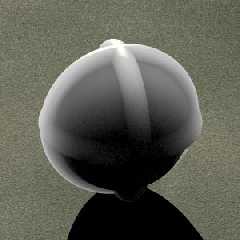|
 |
It's just as I thought..... and I should have done it in the first
place! The solution was obvious..... why hasn't it been done before? At
least I learned a few things from my blob fiasco.
What I'm talking about is the fact that subsurface scattering is 20
times more easy to implement in mlPOV than the official version. The
results are slightly faster and smoother, too. The image you see was
created by the code below:
#declare lpos1=<.5,1,3.25>*100000;
light_source{lpos1,<1.6 1.6 1.1> }
plane{y,-6.75 pigment{bumps scale 25 turbulence .5 lambda 3 poly_wave
.6} normal{granite .2}}
#declare obj=
union{
torus{6,1}
torus{6,1 rotate z*90}
torus{6,1 rotate x*90}
sphere{0,6}
}
object{
obj
pigment{ average
pigment_map{
#local V=0;
#while(V<100)
[1 projection obj ,lpos1 blur .2,10
translate<rand(R)-rand(R),rand(R)-rand(R),rand(R)-rand(R)>*2
color_map { [0 rgb 1][1 rgb 0] }
]
#local V=V+1;
#end
}
}
finish{diffuse 0 ambient 1
specular .5 roughness .05
}
}
--
Samuel Benge
stb### [at] hotmail com
See my website@: http://www.goldrush.com/~abenge/Top/index.html com
See my website@: http://www.goldrush.com/~abenge/Top/index.html
Post a reply to this message
Attachments:
Download 'mlpov_sss.jpg' (19 KB)
Preview of image 'mlpov_sss.jpg'

|
 |




![]()